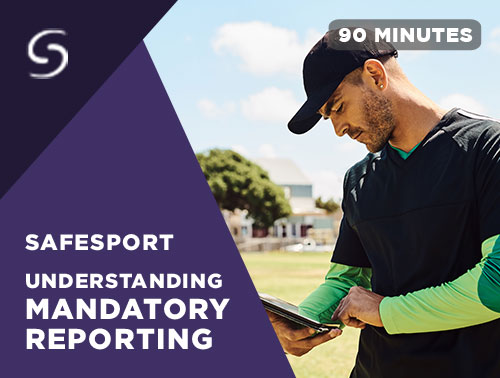Courses to Get You
SafeSport®
Trained
Courses to Get You SafeSport® Trained

Join our email list!
Stay connected with the latest news, resources, and tools from the U.S. Center for SafeSport and enjoy our quarterly e-newsletter, The Gameplan.
Check your email inbox to confirm your U.S. Center for SafeSport Gameplan newsletter subscription.
Learn To Create Safer Sport Environments
Abuse prevention education can help change sport culture. It empowers athletes, coaches, and others in the sport community to recognize, prevent, and respond to abuse. Our online courses will help you get the information and practical skills you need to create a safe, supportive sport environment.
Learn more about these courses and how to choose the right one for yourself or your organization. There is a course for every sport audience, including coaches, medical professionals, parents, and athletes of all ages.
If you are an Adult Participant in the U.S. Olympic and Paralympic Movement (“the Movement”), you may have to take the four-part SafeSport® Trained course cycle. Use our Quad Training Cycle flow chart to understand what course(s) you should take to become and stay SafeSport® Trained.
Learn if you are in-Movement. If so, take our courses for free. If not, consider our affordable and flexible purchasing options.
Find The Right Course For You
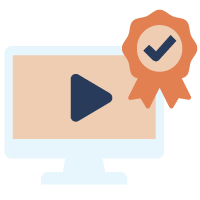
SafeSport® Trained Series
A series on prevention education required for some Movement Participants.
Continued Education
Increase your knowledge of reporting, policies, and other steps to protect athletes.

SafeSport® Trained Series
A series on prevention education required for some Movement Participants.
Safesport® Trained Core
ESTIMATED TIME: 90 MINUTES
This online course is based on best practices in abuse prevention education and the SafeSport Code. It was developed for Participants in the U.S. Olympic and Paralympic Movement but can be used by anyone interested in learning the basic requirements for creating an environment that puts athlete safety first. It uses videos, quizzes, and scenarios to help you learn about and prevent sexual, emotional, and physical abuse and misconduct.
After completing this course, you will be able to:
- Recognize factors unique to sport that can make athletes more vulnerable to abuse
- Apply researched-based strategies that can help protect athletes
- Know when and how to report abuse and misconduct
- Understand why following the SafeSport Code helps create a safer and more positive sport environment
While some course information may not directly apply to you, it will teach you the basic requirements for creating an environment that puts athlete safety first.
You must take this course if:
- You are an Adult Participant in the U.S. Olympic and Paralympic Movement who has authority over or regular contact with minor athletes in the Movement
- Your organization requires it
You should consider taking this course if:
- You are not in or connected to the Movement but have regular contact with minor athletes
- You are interested in learning more about how to prevent and respond to athlete abuse
Note: Are you a licensed health care professional? You can also take the Health Professionals: Your Role in Preventing Abuse in Sports course to fulfill your SafeSport® Trained Core course completion requirements.
This course has three units. The topics covered include:
Unit 1: Sexual Misconduct Awareness Education
Preventing abuse starts with recognizing it. This unit will help you identify Sexual Abuse and Misconduct as defined by the SafeSport Code. You will go through scenarios to see how abuse and misconduct can look in a sport setting.
You will also learn:
- Why the imbalance of power in coach-athlete relationships makes athletes more vulnerable to abuse
- How child sexual abuse starts (i.e., grooming) and ways victims may respond
- Strategies for making travel, locker rooms, and other high-risk athletic situations safer
Unit 2: Mandatory Reporting
If you are an Adult Participant in the Movement, you must report any behavior that breaks the Code’s policies. This unit will teach you the basics of when and how to report. It will also give you some tips to help you respond to someone sharing about abuse.
You will also learn:
- What a mandated reporter is and the legal requirements for reporting child sexual abuse
- Differences in reporting to the Center, law enforcement, and your sport organization
- Why reporting abuse can be difficult and ways to respond
Unit 3: Emotional and Physical Misconduct
Athletes need emotional support and physical safety to thrive. This unit will teach you to recognize and prevent forms of emotional and physical abuse and misconduct, such as bullying and hazing. You will learn how the Code defines these behaviors and ways to address them.
You will also learn:
- Why hazing negatively affects athletes and teams
- What makes some athletes more vulnerable to harassment
- The difference between tough coaching and emotional or physical misconduct
For Movement Participants
Some National Governing Bodies (NGBs) host SafeSport courses on their own portals, while others direct their members to the U.S. Center for SafeSport’s learning portal. Ask your NGB’s member services liaison how you should access SafeSport courses.
For Individuals and Outside Organizations
If you are an individual or represent an organization or group not affiliated with the U.S. Olympic and Paralympic Movement, you can still access the training. To contact us and learn more, fill out this Training Purchase Inquiry Form.
Accessibility for All
We have designed our online courses to be accessible to everyone. This course:
- Is available in multiple languages, including English, Spanish, and French
- Is compatible with most modern web browsers, such as Google Chrome
- Can be completed with assistive technology, such as screen readers and keyboard navigation
If you need additional help navigating this course or want to learn more about our accessibility options, email us at [email protected].
Yes. The only way to become SafeSport® Trained is to take the SafeSport® Trained Core course.* After completing the Core course, you will receive a Certificate of Completion for your records. Download the certificate from the “Transcript” section of your account if you took the course on the U.S. Center for SafeSport’s learning portal. You may need to ask your organization how to download the certificate if you used a learning portal provided by your National Governing Body or non-Movement sport organization.
If you will be in contact with minor athletes, you must take the Core course before any contact occurs. Otherwise, you must take the course within the first 45 days of joining the Movement. Your SafeSport® Trained status is good for 12 months. After taking the Core course, you must take one Refresher course every 12 months to keep your SafeSport® Trained status. You must take the Refresher courses in order, starting with Refresher 1 and ending with Refresher 3:
- Refresher 1: Recognizing and Reporting Misconduct
- Refresher 2: Preventing Misconduct
- Refresher 3: Creating a Positive Sport Environment
After you have taken all three Refresher courses, you will begin the cycle again with the SafeSport® Trained Core course. The Center updates these courses regularly. When you restart the cycle, you will have access to new information, including any updates made to the SafeSport Code and the Minor Athlete Abuse Prevention Policies (MAAPP).
*Licensed mental health professionals and other health care providers can take the equivalent course Health Professionals: Your Role in Preventing Abuse in Sport.
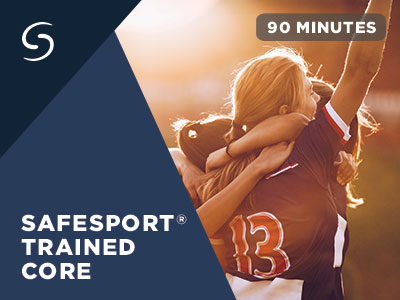
Refresher 1: Recognizing And Reporting Misconduct
ESTIMATED TIME: 30 MINUTES
This online course is designed to help you review the information you learned in the SafeSport® Trained Core course. It addresses key topics covered in the Core, such as sexual misconduct and child abuse. If you are an Adult Participant in the U.S. Olympic and Paralympic Movement, it will also remind you of your responsibilities under the SafeSport Code.
Completing Refresher 1 will strengthen your understanding of:
- The forms of misconduct in sport, including sexual misconduct
- Methods used to commit child sexual abuse and potential warning signs
- Handling disclosures of misconduct and abuse
- When and how to make a report
You should only take this course if you have already taken the SafeSport® Trained Core course.
You must take this course if:
- You are an Adult Participant in the Movement who must maintain SafeSport® Trained status (e.g., someone who has regular contact with or authority over minor athletes) and it has been 12 months since you completed the SafeSport® Trained Core course
- You are a licensed mental health professional or health care provider and it has been 12 months since you completed the Health Professionals: Your Role in Preventing Abuse in Sport course
You should consider taking this course if:
- You have already completed the SafeSport® Trained Core course
- You are not in or connected to the Movement but have regular contact with athletes under age 18
- You are interested in learning more about how to prevent and respond to athlete abuse
This course has one unit. The topics covered include:
Sexual Misconduct and Abuse
You will learn more about forms of sexual misconduct and abuse, including possible differences between the SafeSport Code, federal laws, and state laws. You also will complete an activity to help you define forms of sexual misconduct and identify them when they occur.
Signs and Symptoms of Abuse
You will examine the warning signs and symptoms of abuse and how to support athletes even if they don’t come forward to share about abuse.
Reporting
You will review your reporting duties according to the SafeSport Code, state laws, and federal laws. You will also learn more about how to listen and respond to disclosures of abuse.
For Movement Participants
Some National Governing Bodies (NGBs) host SafeSport courses on their own learning portals, while others direct their members to the U.S. Center for SafeSport’s learning portal. Ask your NGB’s member services liaison how you should access SafeSport courses.
For Individuals and Outside Organizations
If you are an individual or represent an organization or group not affiliated with the U.S. Olympic and Paralympic Movement, you can still access the course. To find out more, fill out this Training Purchase Inquiry Form.
Accessibility for All
We have designed our online courses to be accessible to everyone. This course:
- Is available in multiple languages, including English, Spanish, and French
- Is compatible with most modern web browsers, such as Google Chrome
- Can be completed with assistive technology, such as screen readers and keyboard navigation
If you need additional help navigating this course or want to learn more about our accessibility options, email us at [email protected].
The only way to become SafeSport® Trained is to first take the SafeSport® Trained Core course.* After taking the Core course, you must take one Refresher course every 12 months to keep your SafeSport® Trained status. You must take the Refresher courses in order, starting with Refresher 1 and ending with Refresher 3:
- Refresher 1: Recognizing and Reporting Misconduct
- Refresher 2: Preventing Misconduct
- Refresher 3: Creating a Positive Sport Environment
After completing Refresher 1, you will receive a Certificate of Completion for your records. Download the certificate from the “Transcript” section of your account if you took the course on the U.S. Center for SafeSport’s learning portal. You may need to ask your organization how to access the certificate if you used a learning portal provided by your National Governing Body or non-Movement sport organization.
Refresher 1 is the second course in a four-part cycle. After you have taken all three Refresher courses, you will begin the cycle again with the SafeSport® Trained Core course. The Center updates these courses regularly. When you restart the cycle, you will have access to new information, including any updates made to the SafeSport Code and the Minor Athlete Abuse Prevention Policies (MAAPP).
*Licensed mental health professionals and other health care providers can take the equivalent course Health Professionals: Your Role in Preventing Abuse in Sport.
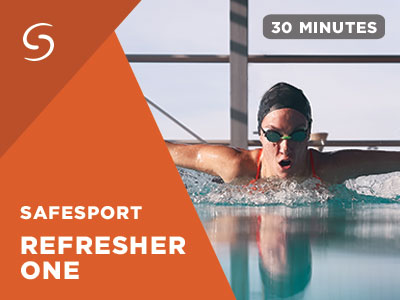
Refresher 2: Preventing Misconduct
ESTIMATED TIME: 30 MINUTES
This online course will help you review the information you learned in the SafeSport® Trained Core course. While you may remember much of what you learned about types of abuse and misconduct, this course can help increase your confidence in identifying and reporting them. During this course, you will reinforce your knowledge through quizzes and scenarios featuring examples you may encounter in a sport environment.
Completing Refresher 2 will reinforce your understanding of:
- Types of misconduct covered under the SafeSport Code
- Your reporting responsibilities, including what and how to report
- The Minor Athlete Abuse Prevention Policies (MAAPP) in place to protect athletes
You should only take this course if you have already taken the SafeSport® Trained Core course.
You must take this course if:
- You are an Adult Participant in the U.S. Olympic and Paralympic Movement who must maintain SafeSport® Trained status (e.g., someone who has regular contact with or authority over minor athletes)
- You have taken the SafeSport® Trained Core* course and it has been 12 months since you completed the Refresher 1: Recognizing and Preventing Misconduct course
You should consider taking this course if:
- You have already completed the SafeSport® Trained Core* course (you may have taken the Refresher 1 course as well)
- You are not in or connected to the Movement but have regular contact with minor athletes
- You are interested in learning more about how to prevent and respond to athlete abuse
*If you are a licensed mental health professional or health care provider, you may have taken the equivalent course Health Professionals: Your Role in Preventing Abuse in Sport.
This course has three units. The topics covered include:
Unit 1: Recognizing Misconduct
You will review the forms of misconduct covered in the Core course and go over three big ideas about each concept to help you remember their key points. This unit also points out some differences between Code policies and state or federal laws.
After completing this unit, you will be able to:
- Define various types of misconduct and abuse
- Use the examples given in the unit to help recognize misconduct or abuse you may encounter in sport
- Identify harmful misinformation about topics, such as child sexual abuse and hazing
Unit 2: Reporting Responsibilities
Knowing when and how to report abuse can be confusing. If you are an Adult connected to the Movement, you must follow the Code’s policies on reporting. And there are state and federal laws you may need to follow—especially if you become aware of possible child sexual abuse.
After reading the information and engaging with the scenarios in this unit, you will:
- Have a better understanding of your reporting responsibilities, including how to listen to disclosures of abuse
- Know the policies around retaliation for reporting
- Understand why it is important for you to report and intervene
Unit 3: Preventing Abuse and Protecting Athletes
You will learn more about how to protect young athletes by applying the Minor Athlete Abuse Prevention Policies (MAAPP). Even if you do not work with minors, consider modifying some of the policies—such as making one-on-one interactions observable and interruptible—for athletes of any age.
After completing this unit, you will:
- Know how the MAAPP policies apply to travel, social media, locker rooms, and other common sport situations
- Have strategies for strengthening the basic MAAPP requirements
- Understand why these policies are important to athlete safety
For Movement Participants
Some National Governing Bodies (NGBs) host SafeSport courses on their own learning portals, while others direct their members to the U.S. Center for SafeSport’s learning portal. Ask your NGB’s member services liaison how you should access SafeSport courses.
For Individuals and Outside Organizations
If you are an individual or represent an organization or group not affiliated with the U.S. Olympic and Paralympic Movement, you can still access the training. To find out more, fill out this Training Purchase Inquiry Form.
Accessibility for All
We have designed our online courses to be accessible to everyone. This course:
- Is available in multiple languages, including English, Spanish, and French
- Is compatible with most modern web browsers, such as Google Chrome
- Can be completed with assistive technology, such as screen readers and keyboard navigation
If you need additional help navigating this course or want to learn more about our accessibility options, email us at [email protected].
The only way to become SafeSport® Trained is to first take the SafeSport® Trained Core course.* After taking the Core course, you must take one Refresher course every 12 months to keep your SafeSport® Trained status. You must take the Refresher courses in order, starting with Refresher 1 and ending with Refresher 3:
- Refresher 1: Recognizing and Reporting Misconduct
- Refresher 2: Preventing Misconduct
- Refresher 3: Creating a Positive Sport Environment
After completing Refresher 2, you will receive a Certificate of Completion for your records. Download the certificate from the “Transcript” section of your account if you took the course on the U.S. Center for SafeSport’s learning portal. You may need to ask your organization how to access the certificate if you used a learning portal provided by your National Governing Body or non-Movement sport organization.
Refresher 2 is the third course in a four-part cycle. After you have taken all three Refresher courses, you will begin the cycle again with the SafeSport® Trained Core course. The Center updates these courses regularly. When you restart the cycle, you will have access to new information, including any updates made to the SafeSport Code and the Minor Athlete Abuse Prevention Policies (MAAPP).
*Licensed mental health professionals and other health care providers can take the equivalent course Health Professionals: Your Role in Preventing Abuse in Sport.
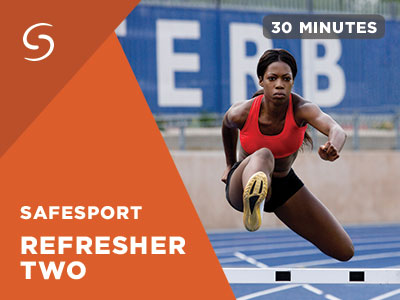
Refresher 3: Creating A Positive Sport Environment
ESTIMATED TIME: 30 MINUTES
This online course is the last in the cycle of SafeSport courses required for Adult Participants in the U.S. Olympic and Paralympic Movement. Like the other Refresher courses, this course will help you deepen your understanding of key concepts covered in the SafeSport® Trained Core course. It will also remind you of your responsibilities under the SafeSport Code and the Minor Athlete Abuse Prevention Policies (MAAPP).
Completing Refresher 3 will strengthen your ability to:
- Recognize types of misconduct, including those that violate the Code and the MAAPP
- Use intervention strategies to protect athletes and create a safer sport environment
- Report any misconduct and abuse you may encounter
You should only take this course if you have already taken the SafeSport® Trained Core course.
You must take this course if:
- You are an Adult Participant in the U.S. Olympic and Paralympic Movement who must maintain SafeSport® Trained status (e.g., someone who has regular contact with or authority over minor athletes)
- You have taken every other course in the SafeSport® Trained cycle and it has been 12 months since you completed the Refresher 2: Preventing Misconduct course
You should consider taking this course if:
- You have already completed the SafeSport® Trained Core* course (you may have taken the other courses in the Refresher series as well)
- You are not in or connected to the Movement but have regular contact with minor athletes
- You are interested in learning more about how to prevent and respond to athlete abuse
*If you are a licensed mental health professional or health care provider, you may have taken the equivalent course Health Professionals: Your Role in Preventing Abuse in Sport.
This course has five units. The topics covered include:
Unit 1: Types of Misconduct
You will begin this unit by reviewing forms of sexual, emotional, and physical misconduct. You will also learn more about how to identify child sexual abuse, including minor-to-minor sexual misconduct.
After completing this unit, you will also be able to:
- Identify hazing and bullying behaviors
- Recognize Willful Tolerance—how adults encourage problematic behavior
Unit 2: Reporting and Responding to Misconduct
This unit will reinforce your knowledge about what, when, and where to report. It also includes practical resources to help you respond to disclosures of abuse.
This unit will help you understand your role in reporting, including:
- What information to include when making a report
- Strategies for responding to disclosures with empathy
Unit 3: Retaliation
During this unit, you will engage with scenarios to learn more about retaliation and how it harms everyone involved—from the target to the broader sport organization.
After completing this unit, you will know:
- How to identify retaliation
- When and where to report suspected retaliation
Unit 4: The MAAPP
This unit will help you review the Minor Athlete Abuse Prevention Policies (MAAPP) and give you practical tips for how to apply the policies.
This unit will empower you to:
- Identify MAAPP violations and take steps to correct them
- Use the MAAPP to create safer environments for minor athletes
Unit 5: Preventing Misconduct
The bystander intervention strategies you review in this unit will help you respond to and prevent misconduct. You will engage with scenarios to learn how to apply the 5 D’s of bystander intervention: Distract, Delegate, Document, Delay, and Direct.
After competing this unit, you will:
- Understand the importance of bystander intervention
- Have strategies for intervening in different situations—including when there is an imbalance of power
For Movement Participants
Some National Governing Bodies (NGBs) host SafeSport courses on their own learning portals, while others direct their members to the U.S. Center for SafeSport’s learning portal. Ask your NGB’s member services liaison how you should access SafeSport courses.
For Individuals and Outside Organizations
If you are an individual or represent an organization or group not affiliated with the U.S. Olympic and Paralympic Movement, you can still access the training. To find out more, fill out this Training Purchase Inquiry Form.
Accessibility for All
We have designed our online courses to be accessible to everyone. This course:
- Is available in multiple languages, including English, Spanish, and French
- Is compatible with most modern web browsers, such as Google Chrome
- Can be completed with assistive technology, such as screen readers and keyboard navigation
If you need additional help navigating this course or want to learn more about our accessibility options, email us at [email protected].
The only way to become SafeSport® Trained is to first take the SafeSport® Trained Core course.* After taking the Core course, you must take one Refresher course every 12 months to keep your SafeSport® Trained status. You must take the Refresher courses in order, starting with Refresher 1 and ending with Refresher 3:
- Refresher 1: Recognizing and Reporting Misconduct
- Refresher 2: Preventing Misconduct
- Refresher 3: Creating a Positive Sport Environment
After completing Refresher 3, you will receive a Certificate of Completion for your records. Download the certificate from the “Transcript” section of your account if you took the course at U.S. Center for SafeSport’s learning portal. You may need to ask your organization how to access the certificate if you used a learning portal provided by your National Governing Body or non-Movement sport organization.
Refresher 3 is the final course in a four-part cycle. In 12 months, you will begin the cycle again with the SafeSport® Trained Core course. The Center updates these courses regularly. When you restart the cycle, you will have access to new information, including any updates made to the SafeSport Code and the Minor Athlete Abuse Prevention Policies (MAAPP).
*Licensed mental health professionals and other health care providers can take the equivalent course Health Professionals: Your Role in Preventing Abuse in Sport.
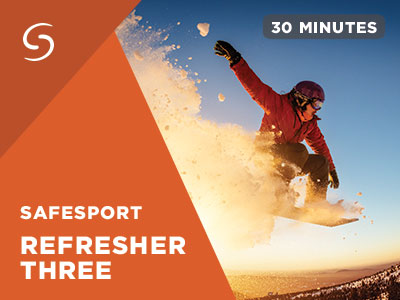
Health Professionals: Your Role In Preventing Abuse In Sport
ESTIMATED TIME: 90 MINUTES
This online course helps health care professionals working with athletes understand their role in responding to, reporting, and preventing abuse and misconduct in sport environments. The course examines factors unique to sport that increase athletes’ risk of abuse. It also offers strategies to help you create safe spaces for athletes’ training and treatment.
Completing this course will empower you to:
- Recognize abuse and misconduct in sport environments
- Use and recommend best practices for minimizing athlete abuse in health care settings
- Apply a trauma-informed approach while providing health care for athletes
- Use bystander intervention strategies to prevent abuse and misconduct
You must take this course if:
- You are a health care professional working with Athletes in the U.S. Olympic and Paralympic Movement
You should consider taking this course if:
- You provide health care for athletes (e.g., physicians, athletic trainers, nutritionists, nurses, etc.)
- You are interested in learning more about how to prevent and respond to athlete abuse
This course has four units. The topics covered include:
Unit 1: Before Abuse Is Disclosed
This unit will prepare you to recognize behavioral “red flags” that increase the risk for athlete abuse in medical settings. It goes over important concepts, such as consent, and defines types of abuse and misconduct. It also gives tips for creating safe spaces for training and treatment, including prevention policies for both adults and minors.
Completing this unit will help you:
- Identify your role in preventing athlete abuse (e.g., create an open, trusting, safe environment)
- Use your expertise to lead the development of abuse prevention policy
Unit 2: When Abuse Is Disclosed
Your response to an athlete’s disclosure of abuse can be an important part of their reporting and healing process. This unit will give you tips for responding to disclosures from both adult and youth athletes. It also offers resources you can share to support athletes who have experienced abuse.
The information in this unit will also help you:
- Learn more about your reporting responsibilities, including how to make a report
- Understand some of the barriers to reporting, such as fear of retaliation
Unit 3: After Abuse Is Disclosed
Applying a trauma-informed approach can help you care for athletes who have experienced abuse or misconduct, even if they have not disclosed it to you. This unit will help you learn about and use the “4 R’s” of a trauma-informed approach: realize, recognize, respond, and resist re-traumatization.
You will also learn:
- To define and identify various forms of trauma, such as abuse and neglect and community violence
- To help athletes deal with circumstances (i.e., “situational triggers”) that can re-traumatize them
Unit 4: Prevention
This unit introduces you to actions you can take on multiple levels—individual, relationship, community, and society—to change sport culture. It also explains how to use the “5 D’s of bystander intervention” to lessen the chance that abuse and misconduct will happen or continue to happen.
Completing this unit will help you:
- Engage with others in sport to change sport culture and protect athletes
- Take immediate action when witnessing potential for a situation that could lead to abuse or misconduct
For Movement Participants
Some National Governing Bodies (NGBs) host SafeSport courses on their own learning portals, while others direct their members to the U.S. Center for SafeSport’s learning portal. Ask your NGB’s member services liaison how you should access SafeSport courses.
For Individuals and Outside Organizations
If you are an individual or represent an organization or group not affiliated with the U.S. Olympic and Paralympic Movement, you can still access the training. To find out more, fill out this Training Purchase Inquiry Form.
Accessibility for All
We have designed our online courses to be accessible to everyone. This course:
- Is available fully narrated in English, Spanish, and French
- Is compatible with most modern web browsers, such as Google Chrome
- Can be completed with assistive technology, such as screen readers and keyboard navigation
If you need additional help navigating this course or want to learn more about our accessibility options, email us at [email protected].
If you are a licensed health care professional, you can become SafeSport® Trained by taking the Health Professionals: Your Role in Preventing Abuse in Sport course instead of the SafeSport® Trained Core course. The two courses are equivalent. Submit a ticket to be registered as SafeSport® Trained.
If you have regular contact with or authority over minor athletes, you must take either course before that contact begins. Otherwise, you must take the course within the first 45 days of joining the Movement. To keep your status, you must take the SafeSport Refresher courses every 12 months, starting with Refresher 1 and ending with Refresher 3:
- Refresher 1: Recognizing and Reporting Misconduct
- Refresher 2: Preventing Misconduct
- Refresher 3: Creating a Positive Sport Environment
After you have taken all three Refresher courses, you will begin the cycle again with the SafeSport® Trained Core course. The Center updates these courses regularly. When you restart the cycle, you will have access to new information, including any updates made to the SafeSport Code and the Minor Athlete Abuse Prevention Policies (MAAPP).
If you are not a licensed health care professional, the only way to become SafeSport® Trained is to take the Core course. Please check with your organization to make sure you are taking the correct course.
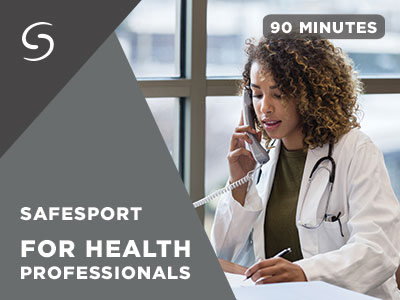

Empowered Families
Get abuse prevention tools for parents/guardians, teens, and kids.
Parent’s Guide To Misconduct In Sport
ESTIMATED TIME: 30 MINUTES
This free online course is for parents and guardians. It shares best practices for protecting youth athletes from abuse and misconduct. It also gives an overview of the SafeSport Code—a set of policies and standards of conduct. While Participants in the U.S. Olympic and Paralympic Movement must follow the Code, it can also be used as a guide by parents and guardians of any sport organization to help create a safer sport environment for their children.
If you are a sport organization administrator, empower the parents and guardians in your organization to protect youth athletes by sharing this course.
If you are a parent or guardian, take this course to learn:
- What makes a healthy coach-athlete relationship
- How to recognize forms of abuse and misconduct in sport
- Tips for talking to your child about misconduct and encouraging them to report it
- Ways to make sport situations safer for your child
You should consider taking this course if:
- Your child is a Participant in the Movement or any sport organization
- You are interested in learning more about how to prevent and respond to athlete abuse
You should consider sharing this course if:
- You are a sport administrator in the Movement and need to educate parents and guardians of minor athletes about the SafeSport Code
- You work with any sport organization and want to help parents and guardians create safer, more positive sport environments
Note: This course does not satisfy the SafeSport® Trained Core course completion requirement. If you are a parent or guardian who works within the U.S. Olympic and Paralympic Movement as a volunteer or in another role, you may need to take the SafeSport® Trained Core course. Please check with your organization to make sure you are taking the correct course.
This course has five units. The topics covered include:
Unit 1: Introduction to the U.S. Center for SafeSport
This unit will help you understand what sports organizations should do to provide a positive sport experience. It starts with policies promoting healthy coach-athlete relationships. You will also learn what questions you should ask your child’s coach, camp, or sport organization to assess their safety practices.
After completing this unit, you will:
- Know how the U.S. Center for SafeSport is working to support athletes
- Understand the roles that trust and power play in the coach-athlete relationship
- Be prepared to talk about safety with those involved in your child’s sport experience
Unit 2: Sexual Abuse and Misconduct
An important part of protecting youth athletes from sexual abuse and misconduct is knowing when a behavior violates a law or policy. In this unit, you will learn how sexual misconduct and abuse are defined under the law and in the SafeSport Code. You will also learn about how grooming tactics and consent play a role in abuse.
The videos and activity in this unit will help you understand:
- The factors unique to sport that put youth at risk
- How grooming extends beyond youth to their communities
- What you and your child should understand about consent
Unit 3: Other Forms of Misconduct
In this unit, you will learn about barriers to creating a positive sport environment, including bullying behavior, hazing, emotional misconduct, and physical misconduct. In addition to the definitions, you will review examples of these behaviors to help you spot them in a sport setting.
In this unit, you will learn:
- To recognize bullying and harassment behaviors, including cyberbullying
- How hazing hurts both individual athletes and teams
- The difference between motivation and emotional or physical misconduct
Unit 4: Create Safe Environments
This unit gives an overview of policies that can reduce risk in some of the most common high-risk sport situations. You will also learn more about what organizations can do to protect youth athletes. You can use this information to make sure your child’s sport organization is using best practices.
After completing this unit, you will know:
- The importance of limiting one-on-one interactions
- How to identify risky locker room situations and tips for addressing them
- Ways to keep local and overnight travel safer for your child and their team
Unit 5: Responding to Misconduct
Abuse and misconduct must be reported before they can be addressed. However, talking about abuse can be difficult for both youth and adults. In this unit, you will learn what you can do to help your child feel more comfortable reporting abuse.
Reviewing this unit will help you:
- Talk to your child about misconduct and help them report it
- Recognize common signs and symptoms of sexual abuse
- Follow laws and your child’s sport organization’s policies for reporting
Free Access
This course is free. If you are a parent or guardian, you can:
- Contact your child’s sport organization to find out if it offers the course through its own learning platform
- Set up your own account at the SafeSport® Trained learning portal
If you are a sport organization administrator and want to offer the course through your organization’s website, fill out this Training Purchase Inquiry Form to contact us.
Accessibility for All
We have designed our online courses to be accessible to everyone. This course:
- Is available in English, Spanish, and French
- Is compatible with most modern web browsers, such as Google Chrome
- Can be completed with assistive technology, such as screen readers and keyboard navigation
If you need additional help navigating this course or want to learn more about our accessibility options, email us at [email protected].
Everyone involved with sport should know how to prevent, recognize, and respond to abuse and misconduct. In addition to this course for parents and guardians, we also have courses that teach young athletes about their right to a safe sport environment. Consider having your child take one of these courses:
- SafeSport® for Kids (Ages 5-12)
- SafeSport® for Youth Athletes (Ages 13-17)
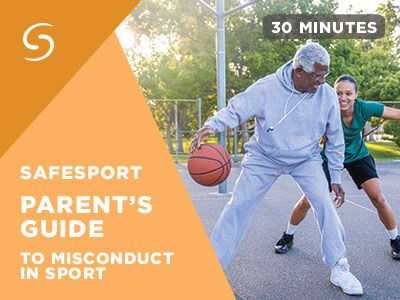
SafeSport® For Kids (Ages 5-12)
ESTIMATED TIME: 15 MINUTES
Young athletes can take this free online course with their parents or guardians. It uses interactive elements to help children understand how people should behave in a healthy sport environment. It also uses developmentally appropriate language and activities to help youth recognize and call out abuse and misconduct.
This course empowers youth athletes through:
- Defining and setting an expectation for a positive sport experience
- Helping them identify healthy and unhealthy behavior in sport
- Teaching youth they have a right to set and enforce boundaries
Youth athletes ages 5-12 should take this course with the permission and/or participation of a parent or guardian.
- If you are a sport administrator, consider sharing this course with the parents in your organization
- If you are a parent, consider having your child take this course to learn more about positive behavior in sport
This course has three units. The topics covered include:
Unit 1: FUN
In this unit, children will learn about the basics of a healthy sport environment.
It will help them:
- Understand sport is about more than winning
- Talk to their parent or guardian about what they enjoy in sport
Unit 2: Cool or Not Cool?
In this unit, children play a game that emphasizes the importance of treating teammates with respect to help make sports fun and safe for everyone.
They will learn to:
- Recognize actions that show good sportsmanship
- Recognize behaviors like bullying and emotional misconduct
Unit 3: Out of Bounds
In this unit, children learn about body boundaries through the animated video “It’s Your Body.”
They will also learn:
- It’s not their fault if an adult or peer crosses their boundaries
- The importance of telling a trusted adult if they are scared, hurt, or confused
Free Access
This course is free. If you are a parent or guardian, help your child access the course by:
- Contacting your child’s sport organization to find out if it offers the course through its own learning platform
- Setting up an account at the SafeSport® Trained learning portal
Youth should have permission from their parent or guardian before taking this course. Before your child accesses the course, please read the slide “A Note to Parents.” Select “Acknowledge” to grant permission for your child to continue. Consider taking the course with your child and using the parent tips in each section to start a discussion.
If you are a sport organization administrator and want to offer the course through your organization’s website, fill out this Training Purchase Inquiry Form to contact us.
Accessibility for All
This course:
- Is available in English, Spanish, and French
- Is compatible with most modern web browsers, such as Google Chrome
- Can be completed with assistive technology, such as screen readers and keyboard navigation
If you need additional help navigating this course or want to learn more about our accessibility options, email us at [email protected].
Everyone involved with sport should know how to prevent, recognize, and respond to abuse and misconduct. In addition to this course for kids (ages 5-12), we also offer courses for older youth and parents:
- SafeSport® for Youth Athletes (Ages 13-17)
- Parent’s Guide to Misconduct in Sport
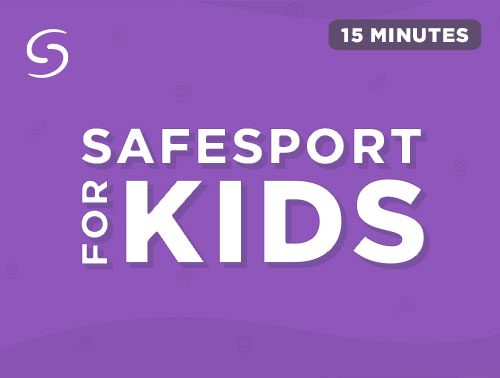
SafeSport® For Youth Athletes (Ages 13-17)
ESTIMATED TIME: 20 MINUTES
This free online course teaches young athletes they have a right to a positive and safe sport experience. The course uses developmentally appropriate language and scenarios to explain difficult topics like physical, emotional, and sexual misconduct.
If you work with youth athletes, either in or outside of the U.S. Olympic and Paralympic Movement, encourage them and their families to use this course to learn about the SafeSport Code. While Movement Participants must follow the Code, it sets standards of conduct—like no Hazing—that all athletes should follow to help protect themselves and their teammates.
This course empowers youth athletes through:
- Helping them learn to identify abuse and misconduct
- Teaching them bystander intervention strategies
- Encouraging them to speak up and report if they see abuse and misconduct
Youth athletes ages 13-17 should consider taking this course if:
- They play in any sport organization and want to create a positive sport environment for themselves and their teammates
- They are Participants in the U.S. Olympic and Paralympic Movement required to follow the SafeSport Code
- They have the permission of their parent or guardian
Note: This course does not satisfy the SafeSport® Trained Core course completion requirement. Older youth in the Movement (i.e., ages 17 and 18) may be required to take the SafeSport® Trained Core course—especially if there are minor athletes on their team. Please check with your child’s National Governing Body (NGB) to find out what their requirements are and to ensure your child is taking the correct course.
This course has three units. The topics covered include:
Unit 1: It’s Your Body
This unit helps youth athletes understand what behavior they should expect from others in a sport environment. They also learn how to identify behaviors such as physical misconduct, sexual harassment, and sexual misconduct.
After completing this unit, youth will understand:
- They have a right to respect while playing sport
- The importance of asking for consent
Unit 2: Strengthening Your Team
Being part of a team can be a great experience for young athletes. This unit helps youth recognize negative behavior, like cyberbullying and hazing, and encourages them to speak up for the good of their team.
This unit will help youth athletes:
- Learn the difference between helpful and abusive behavior
- Use bystander intervention strategies to help their teammates
Unit 3: Reporting Abuse
Youth athletes can be unsure of when and how to make a report. In this unit, they learn about resources for reporting abuse, including the U.S. Center for SafeSport. Youth will also use interactive scenarios to better understand how reporting works in situations they may encounter in sport.
After completing this unit, youth will:
- Understand they have more than one way to make a report
- Be empowered to support their peers and teammates by reporting abuse
Free Access
This course is free. If you are a parent or guardian, help your child access the course by:
- Contacting your child’s sport organization to find out if it offers the course through its own learning platform
- Setting up your own account at the SafeSport® Trained learning portal
Youth should have permission from their parent or guardian before taking this course. Before your child accesses the course, please read the slide “A Note to Parents.” Select “Acknowledge” to grant permission for your child to continue.
If you are a sport organization administrator and want to offer the course through your organization’s website, fill out this Training Purchase Inquiry Form to contact us.
Accessibility for All
This course is:
- Is available in English, Spanish, and French
- Compatible with most modern web browsers, such as Google Chrome
- Accessible using assistive technology, such as screen readers and keyboard navigation
If you need additional help navigating this course or want to learn more about our accessibility options, email us at [email protected].
Everyone involved with sport should know how to prevent, recognize, and respond to abuse and misconduct. In addition to this course for youth athletes (ages 13-17), we also offer courses for younger children and parents:
- SafeSport® for Kids (Ages 5-12)
- Parent’s Guide to Misconduct in Sport
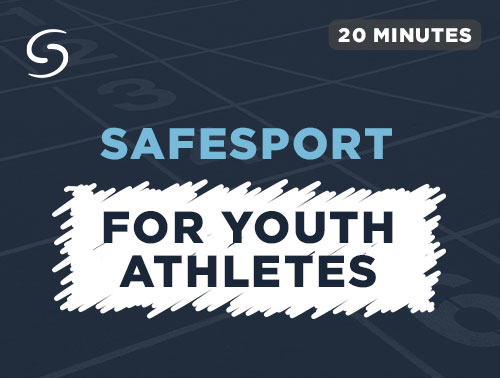
Continued Education
Increase your knowledge of reporting, policies, and other steps to protect athletes.
Abuse Prevention For Adult Athletes
ESTIMATED TIME: 30 MINUTES
This online course highlights the SafeSport Code and other topics specific to Adult Athletes in the U.S. Olympic and Paralympic Movement. It also provides in-depth information about common areas of concern for all adult athletes. If you are an adult athlete in any sport organization, the information in this course can help you create a healthy, positive place to compete. If you are a sport administrator working with adult athletes, consider sharing this course as part of your commitment to providing a safer sport environment.
Some concepts this course covers include:
- Power Imbalance, including how it can sometimes contribute to misconduct
- Consent and the ways it can be compromised
- The what’s, where’s, and how’s of reporting
- What you can do when you see misconduct happening
- How to respond to retaliation from reporting misconduct
You should consider taking this course if:
- You are an adult athlete
- You want to know how to respond to incidents of misconduct
- You are interested in learning more about how to protect yourself and/or your teammates
Note: This course does not satisfy the SafeSport® Trained Core course completion requirement. If you are connected to the U.S Olympic and Paralympic Movement and regularly in contact with minor athletes, you may need to take the SafeSport® Trained Core course. Contact your National Governing Body (NGB) for more information.
This course has three units. The topics covered include:
Unit 1: Power Imbalance
Healthy coach-athlete relationships are foundational to positive sport experiences. This unit discusses how the power imbalance that exists in these and other sport relationships can have both positive and negative effects. It will also lead you through activities designed to help you recognize when you encounter a power imbalance in sport.
After completing this unit, you will know how to:
- Recognize when a power imbalance is being used in an unhealthy way
- Intervene when you see someone in authority misusing their power
Unit 2: Consent
This unit uses video and scenarios to help you explore the concept of consent. It explains how the relationship between consent and power imbalance can lead to abuse and misconduct. It will also help you understand how impairment affects the ability to give consent.
This unit will help you understand:
- What consent is and how it’s defined
- Ways consent may be compromised
Unit 3: Reporting
As an athlete, you may witness or hear about abuse and misconduct. This unit prepares you to respond as a bystander and to follow up through reporting. It will help you understand what, when, and where to report. It also covers what to do in cases of retaliation after reporting.
After completing this unit, you will:
- Know where to report based on your role in sport (e.g., college athlete)
- Be empowered to intervene by using the 3 D’s: Distract, Delegate, and Be Direct
For Movement Participants
Some National Governing Bodies (NGBs) host SafeSport courses on their own portals, while others direct their members to U.S. Center for SafeSport’s learning portal. Ask your NGB’s member services liaison how you should access SafeSport courses.
For Individuals and Outside Organizations
If you are an individual or represent an organization or group not affiliated with the U.S. Olympic and Paralympic Movement, you can still access the course. To contact us and learn more, fill out this Training Purchase Inquiry Form.
Accessibility for All
We have designed our online courses to be accessible to everyone. This course:
- Is available in English, Spanish, and French
- Is compatible with most modern web browsers, such as Google Chrome
- Can be completed with assistive technology, such as screen readers and keyboard navigation
If you need additional help navigating this course or want to learn more about our accessibility options, email us at [email protected].
The Abuse Prevention for Adult Athletes course does not satisfy the Core course completion requirement. The only way to become SafeSport® Trained is to take the SafeSport® Trained Core course.* Check with your organization to see if you need to take the Core course to participate in U.S. Olympic and Paralympic Committee events.
*Licensed mental health professionals and other health care providers can take the equivalent course Health Professionals: Your Role in Preventing Abuse in Sport.
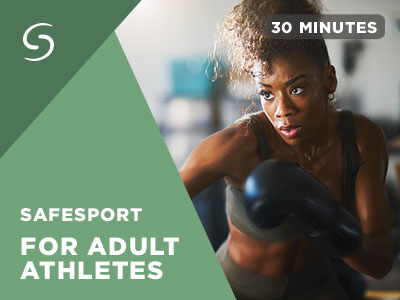
Creating Safe and Inclusive Environments For Athletes With Disabilities
ESTIMATED TIME: 60 MINUTES
This online course will help you create an inclusive sport environment for disabled athletes and other people with disabilities. The course is based on the SafeSport Code, but has prevention information and safety policies any organization can use to help support and safeguard disabled athletes. It also includes outside resources you can use to increase your understanding of disability issues.
The course will help you:
- Understand the risks athletes with disabilities may face in sport environments
- Recognize common types of abuse and misconduct against disabled athletes
- Use best practices for supporting disabled athletes to increase inclusion and safety
- Report abuse and misconduct
You should consider taking this course if:
- You train with, play with, coach, or otherwise participate in sport with a disabled athlete
- You want to build inclusive and accessible sport environments
- You are interested in learning more about how to prevent and respond to athlete abuse
Note: This course does not satisfy the SafeSport® Trained Core course completion requirement. If you are connected to the U.S Olympic and Paralympic Movement and regularly in contact with minor athletes, you may need to take the SafeSport® Trained Core course. Contact your National Governing Body (NGB) for more information.
This course has five units. The topics covered include:
Unit 1: Terminology and Definitions
This unit will help you learn more about disabilities, including physical, sensory, and invisible disabilities. You will also go through scenarios to help you better communicate with disabled athletes about their needs.
After completing this unit, you will have a better understanding of:
- The role of personal care and sport assistants
- How to speak with disabled athletes in a respectful and empowering way
Unit 2: Inclusive Environments
An inclusive sport culture starts with setting expectations for team culture. In this unit you will learn strategies for including disabled athletes, such as using Universal Design when creating sport facilities.
You will also learn:
- Strategies for ensuring disabled athletes are not isolated or excluded during training
- Tips for writing organizational policies that include athletes with disabilities at every step
Unit 3: Working with Athletes with Disabilities
This unit will help you learn more about what coaches, administrators, and volunteers should know when working with athletes with disabilities. It goes over some common misperceptions about the athletes and offers tips for getting past them.
Completing this unit will help you:
- Assess your approach to working with disabled athletes and adjust it to increase support if needed
- Apply policies for safeguarding youth athletes with disabilities, such as preventing unapproved one-on-one interactions
Unit 4: Recognizing Abuse and Misconduct
In this unit, you will learn why athletes with disabilities are more likely to experience abuse and misconduct than athletes without disabilities. You will also review concepts such as consent and grooming, as well as the definitions of specific types of abuse.
After completing this unit, you will be able to:
- Identify environmental, individual, and cultural risk factors for disabled athletes
- Understand how the imbalance of power in sport relationships can affect disabled athletes
Unit 5: Responding to and Reporting Abuse and Misconduct
This unit will prepare you to respond if an athlete shares an experience of abuse and misconduct. It includes tips for handling disclosures and information about where and how to make a report. It also goes over your responsibility to report, including a discussion of mandated reporting.
After finishing this unit, you will understand more about:
- Barriers to reporting athletes with disabilities may face
- What incidents you must report, especially if you are a mandated reporter and/or Participant of the U.S. Olympic and Paralympic Movement
For Movement Participants
Some National Governing Bodies (NGBs) host SafeSport courses on their own learning portals, while others direct their members to the U.S. Center for SafeSport’s learning portal. Ask your NGB’s member services liaison how you should access SafeSport courses.
For Individuals and Outside Organizations
If you are not affiliated with the U.S. Olympic and Paralympic Movement, you can still access the course. To contact us and learn more, fill out this Training Purchase Inquiry Form.
Accessibility for All
We have designed our online courses to be accessible to everyone. This course:
- Is available in English, Spanish, and French
- Is compatible with most modern web browsers, such as Google Chrome
- Can be completed with assistive technology, such as screen readers and keyboard navigation
If you need additional help navigating this course or want to learn more about our accessibility options, email us at [email protected].
The Creating Safe and Inclusive Environments for Athletes with Disabilities course does not meet the SafeSport® Trained Core course completion requirement. The only way to become SafeSport® Trained is to take the Core course.* Check with your organization to see if you need to take the Core course to participate in U.S. Olympic and Paralympic Committee events.
*Licensed mental health professionals and other health care providers can take the equivalent course Health Professionals: Your Role in Preventing Abuse in Sport.
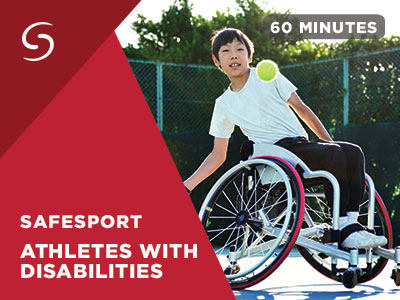
SafeSport® for Volunteers
ESTIMATED TIME: 15 MINUTES
Consider taking this online course if you volunteer with a sport organization. This course will empower you to better support athletes by helping you recognize, prevent, and respond to abuse and misconduct.
The course covers:
- Different forms of misconduct and abuse
- Policies that can help protect athletes of any age
- How to report if you become aware of misconduct or abuse
Consider taking this course if you:
- Are a volunteer for any sport organization
- Want to help provide a safe and supportive environment for athletes
- Are interested in learning more about how to prevent and respond to athlete abuse
Note: This course does not satisfy the SafeSport® Trained Core course completion requirement. If you are connected to the U.S Olympic and Paralympic Movement and regularly in contact with minor athletes, you may need to take the SafeSport® Trained Core course. Contact your National Governing Body (NGB) for more information.
The course has two units. The topics covered include:
Unit 1: Recognizing Abuse and Misconduct
This unit will help you define and recognize various forms of abuse and misconduct, such as emotional misconduct and sexual harassment. It also provides an overview of the policies your organization should have in place to protect athletes.
After completing this unit, you will:
- Have a better understanding of how abuse and misconduct shows up in sport
- Be able to distinguish between actions that are regular to sport (e.g., kicks in combat sport) and abusive (e.g., a coach hitting an athlete for being late)
Unit 2: Reporting Abuse and Misconduct
As a volunteer, you are in the position to notice concerning behaviors that others may not. This unit will prepare you to respond if that happens. You will learn what, when, and how to report and interact with scenarios to help increase your confidence about reporting.
This unit will help you:
- Understand more about your responsibility to report, including if you are a mandatory reporter
- Identify the information you would need to share in a report
For Movement Participants
If you volunteer with the Movement, there is a version of the volunteer course just for you. It includes information about the SafeSport Code and the Minor Athlete Abuse Prevention Policies (MAAPP).
Some National Governing Bodies (NGBs) host SafeSport courses on their own portals, while others direct their members to U.S. Center for SafeSport’s learning portal. Ask your NGB’s member services liaison how you should access SafeSport courses.
For Individuals and Outside Organizations
We have designed a version of the course for volunteers and organizations not connected with the U.S. Olympic and Paralympic Movement. You can learn more about how to access this version by filling out this Training Purchase Inquiry Form.
Accessibility for All
We have designed our online courses to be accessible to everyone. This course:
- Is available in English, Spanish, and French
- Is compatible with most modern web browsers, such as Google Chrome
- Can be completed with assistive technology, such as screen readers and keyboard navigation
If you need additional help navigating this course or want to learn more about our accessibility options, email us at [email protected].
The SafeSport® for Volunteers course does not satisfy the SafeSport® Trained Core course completion requirement. The only way to become SafeSport® Trained is to take the Core course.* Check with your organization to see if you need to take the Core course to participate in U.S. Olympic and Paralympic Committee events.
*Licensed mental health professionals and other health care providers can take the equivalent course Health Professionals: Your Role in Preventing Abuse in Sport.
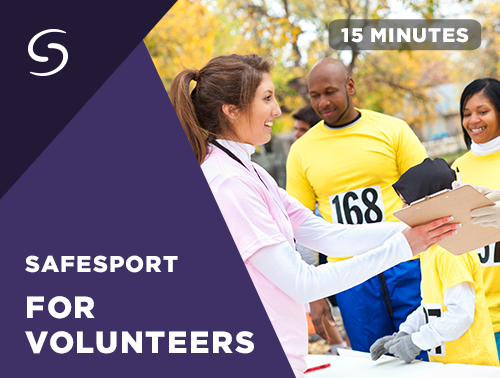
Understanding Mandatory Reporting
ESTIMATED TIME: 90 MINUTES
If you are an Adult Participant in the U.S. Olympic and Paralympic Movement, you must follow the reporting requirements of the SafeSport Code. However, anyone in sport who works with youth athletes may be a mandatory reporter under state and federal law. This online course will help you learn more about being a mandatory reporter, including what, when, and where to report.
By taking this course, you’ll learn to:
- Explain the legal requirements for mandatory reporting of child abuse and neglect
- Recognize child abuse and neglect
- Understand the barriers that prevent mandatory reporters from reporting child abuse and neglect
- Report a concern about child abuse to the correct authorities
You should consider taking this course if:
- You are unclear about your status or duties as a mandatory reporter
- You want more information about how to prevent and respond to athlete abuse
Note: This course does not satisfy the SafeSport® Trained Core course completion requirement. If you are connected to the U.S Olympic and Paralympic Movement and regularly in contact with minor athletes, you may need to take the SafeSport® Trained Core course. Contact your National Governing Body (NGB) for more information.
This course has four units. The topics covered include:
Unit 1: The Law
This unit will help you understand who is usually considered a mandatory reporter under federal and state laws. It also highlights mandatory reporting laws specific to sport organizations, such as the Protecting Young Victims from Sexual Abuse and Safe Sport Authorization Act of 2017.
After completing this unit, you will know:
- How the roles of sport program staff (e.g., coaches, athletic directors, etc.) position them to help protect children
- It is your responsibility to look up your state laws about mandatory reporting
Unit 2: Recognizing Child Abuse and Neglect
The first step in reporting child abuse and neglect is being able to recognize it. This unit defines child abuse and gives examples to help you identify its different forms. It examines social factors, such as domestic violence and drug use, that may contribute to child abuse. It also highlights youth that may be more at risk of abuse, such as youth with disabilities and LGBTQ+ youth.
This unit will help you:
- Recognize behaviors adults exhibit that may indicate child abuse
- Make distinctions between abusive behavior and actions that are related to differences in culture, religion, or wealth
Unit 3: Responding to Disclosures of Child Abuse
When youth share about abuse it is important to respond with empathy. This unit provides “do’s and don’ts” for receiving disclosures of abuse and helping youth feel supported. It also prepares you to make a report by going over how to properly document any disclosures you may receive.
After completing this unit, you will know:
- How to listen for youth making indirect or disguised disclosures
- What not to say to a youth making a disclosure
Unit 4: Reporting Child Abuse and Neglect
This unit gives you the information you need to fulfill your duties as a mandatory reporter. It goes over the timeline for reporting suspected abuse and the possible penalties for not reporting. It also takes you through the reporting process and details the information you should be ready to share when making a report.
Completing this unit will help you:
- Know where, why, when, and how to report
- Overcome barriers to reporting, such as fear of retaliation
For Movement Participants
Some National Governing Bodies (NGBs) host SafeSport courses on their own learning portals, while others direct their members to the U.S. Center for SafeSport’s learning portal. Ask your NGB’s member services liaison how you should access SafeSport courses.
For Individuals and Outside Organizations
If you are an individual or represent an organization or group not affiliated with the U.S. Olympic and Paralympic Movement, you can still access the course. To find out more, fill out this Training Purchase Inquiry Form.
Accessibility for All
We have designed our online courses to be accessible to everyone. This course:
- Is available fully narrated in English, Spanish, and French
- Is compatible with most modern web browsers, such as Google Chrome
- Can be completed using assistive technology, such as screen readers and keyboard navigation
If you need additional help navigating this course or want to learn more about our accessibility options, email us at [email protected].
The Understanding Mandatory Reporting course does not satisfy the SafeSport® Trained Core course completion requirement. The only way to become SafeSport® Trained is to take the Core course.* Check with your organization to see if you need to take the Core course to participate in U.S. Olympic and Paralympic Committee events.
*Licensed mental health professionals and other health care providers can take the equivalent course Health Professionals: Your Role in Preventing Abuse in Sport.
